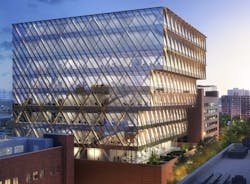Construction of $425M NYC Public Health Lab focused on newest LEED, Energy Efficiency standards
Builders of the NYC Public Health Laboratory project promise the $425 million facility will be one of the most energy efficient and sustainable in New York.
Construction phase one began last month with the demolition of three old buildings. The new NYC Public Health Laboratory will be adjacent to the Harlem Hosital complex on 137th street and was designed by Skidmore, Owings & Merrill with research, staff wellness and energy resiliency and sustainability in mind.
Skanska Building USA is leading the construction work.
The 10-story, 240,000 square-foot building is designed meet LEED (Leadership in Energy and Environmental Design) version 4 Silver energy efficiency standards. The U.S. Green Building Council oversees LEED certification, with Version 4 the latest standards in limiting energy and water usage, among other goals.
The New York City Economic Development Corp. and Department of Mental Health and Hygiene collaborated on securing $25 million in Citywide Administrative services funds to spend on energy efficiency and sustainability technologies.
“New York City has one of the finest public health laboratories in the world, and it’s about time their space reflects the caliber of the work they do,” said NYC Health + Hospitals President and CEO Mitchell Katz, MD. “NYC Health + Hospitals is proud to be neighbors and ongoing collaborative partners in public health.”
Some of the energy conservation measures in the new Public Health Laboratory will be ultra-efficient laboratory equipment, solar photovoltaic panels and chilled beams. It will also have a cogeneration plant to provide significant energy and cost savings.
The new Public Health Laboratory participated in the City’s 80x50 program, which is committed to achieving an 80 percent carbon emissions reduction by the year 2050.
The construction is expected to be completed by 2026. Considered by many as the world's first municipal bacteriological laboratory, the Public Health lab has occupied 11 floors of a building across the street from Bellevue Hospital.
Buildings generate nearly 70 percent of New York City’s greenhouse gas emissions, according to the municipal government statistics. The Mayor’s office and other entities are pushing and requiring numerous green building initiatives to cut down those commercial and industrial site emissions.
-- -- --
(Rod Walton, senior editor for EnergyTech, is a 14-year veteran of covering the energy industry both as a newspaper and trade journalist. He can be reached at [email protected]).
About the Author
Rod Walton, EnergyTech Managing Editor
Managing Editor
For EnergyTech editorial inquiries, please contact Managing Editor Rod Walton at [email protected].
Rod Walton has spent 17 years covering the energy industry as a newspaper and trade journalist. He formerly was energy writer and business editor at the Tulsa World. Later, he spent six years covering the electricity power sector for Pennwell and Clarion Events. He joined Endeavor and EnergyTech in November 2021.
Walton earned his Bachelors degree in journalism from the University of Oklahoma. His career stops include the Moore American, Bartlesville Examiner-Enterprise, Wagoner Tribune and Tulsa World.
EnergyTech is focused on the mission critical and large-scale energy users and their sustainability and resiliency goals. These include the commercial and industrial sectors, as well as the military, universities, data centers and microgrids. The C&I sectors together account for close to 30 percent of greenhouse gas emissions in the U.S.
He was named Managing Editor for Microgrid Knowledge and EnergyTech starting July 1, 2023
Many large-scale energy users such as Fortune 500 companies, and mission-critical users such as military bases, universities, healthcare facilities, public safety and data centers, shifting their energy priorities to reach net-zero carbon goals within the coming decades. These include plans for renewable energy power purchase agreements, but also on-site resiliency projects such as microgrids, combined heat and power, rooftop solar, energy storage, digitalization and building efficiency upgrades.

